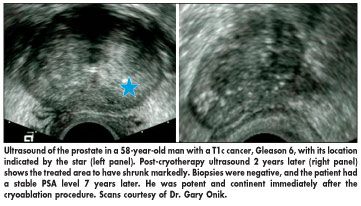'Male Lumpectomy' Via Focal Cryoablation Expands Treatment Options for Selected Prostate Cancer Patients
Focal cryoablation for prostate cancer—the so-called male lumpectomy—appears to be an effective alternative to treatments that involve the whole gland, with lower rates of adverse effects
SEATTLEFocal cryoablation for prostate cancerthe so-called male lumpectomyappears to be an effective alternative to treatments that involve the whole gland, with lower rates of adverse effects, according to a study reported at the Society of Interventional Radiology 32nd Annual Meeting (abstract 102).
"Prostate cancer patients are still being treated with whole-gland surgeryradical prostatectomy. The question is, can we decrease the significant morbidity associated with those procedures if we just treat the cancer area?" said lead author Gary Onik, MD. "The reason we felt we could go ahead and treat patients with local cryoablation is that there is a safety net after treatment: We can carefully monitor patients using PSA levels and biopsies, and we have the ability to retreat them if there is a local recurrence. So, to us, it seemed like this is a rational middle ground between watchful waiting, which is an accepted treatment, and whole-gland therapy."
Urologists might argue that focal cryoablation is not feasible because prostate cancer is multifocal, said Dr. Onik, an interventional radiologist at Florida Hospital/Celebration Health. However, pathology studies suggest that up to 25% of patients have only a single tumor, while up to 60% have an index tumor plus a smaller tumor that may not be clinically significant. "If you look at the slides of those smaller tumors, which are tumors less than 5 mm, the overwhelming majority might be appropriate for focal therapy," he commented.
A critical first step to performing focal cryoablation is to determine exactly where the cancer is located, and neither transrectal ultrasound (TRUS) biopsy nor radiology imaging is adequate for this, according to Dr. Onik. He and his colleagues therefore began performing a 3D mapping biopsy of the prostate. In this procedure, using a brachytherapy grid under ultrasound guidance, a transperineal biopsy is taken every 5 mm throughout the gland. Specimens are labeled according to their location on the grid, which allows the physician to determine the exact location of any cancer that is found. Pathology studies show that this mapping finds about 95% of tumors measuring at least 5 mm, he said.
Dr. Onik and his colleagues performed 250 mapping biopsies, 110 of which were done in men who had previously had a TRUS biopsy that found cancer on only one side. In those 110 patients, the mean number of biopsies was 46 per patient. More than half (55%) were found to have bilateral cancer despite the TRUS results, and 23% had an increase in Gleason score based on mapping results.
"Obviously, without doing a mapping biopsy, we would have undertreated a large number of patients," Dr. Onik commented. The biopsies were well tolerated, with acceptably low rates of temporary Foley catheter placement (8%) and hematuria (less than 1%).
The focal cryoablation is performed transperineally under TRUS guidance, Dr. Onik said. "This is not a minimal treatment in the sense of not being aggressive," he noted. "We are aggressive; we treat outside the gland, and we treat the periprostatic tissue if needed."
A total of 112 patients have undergone the procedure (see Figure). Main analyses were based on 80 patients with a follow-up of 1 to 11 years (mean, 3.3 years). In terms of efficacy, 96% are biochemically free of disease based on the ASTRO definition. "The majority of patients were not minimal-risk patientsthese were not self-selected to do well," he pointed out, with 60% having either medium- or high-risk disease.

Only 6 of the 80 patients had to be retreated because cancer was found in an untreated area after the first procedure; all 6 were biochemically disease free afterward. "There were no local recurrences in any area that we treated, and there were no patients with persistent local disease. So we have 100% local control of prostate cancer with this type of approach," Dr. Onik said.
Kaplan-Meier analyses showed that "failures, if they occur, usually occur early, and we are not seeing a diminution of results over time," he said. "We didn't expect to see better resultswe expected to see worse cancer results because we weren't treating the whole gland. So this was a surprise to us."
Potency was assessed in 66 patients who were potent before treatment and had 1 year of follow-up: 90% of these patients were potent to their satisfaction, with or without oral agents. Continence was assessed in 109 patients, all of whom were continent after the procedure.
"The majority of prostate cancer patients may be candidates for focal therapy, and with this lumpectomy type of approach, the results are very encouraging," Dr. Onik said. "The results appear to be better than traditional treatments, particularly in the medium- and high-risk patients, and morbidity is lower than that of traditional treatmentsthere is a high potency rate and negligible incontinence." Although this is only one case series, he said, "I think the reduced morbidity with focal cryoablation justifies larger controlled trials."
Newsletter
Stay up to date on recent advances in the multidisciplinary approach to cancer.